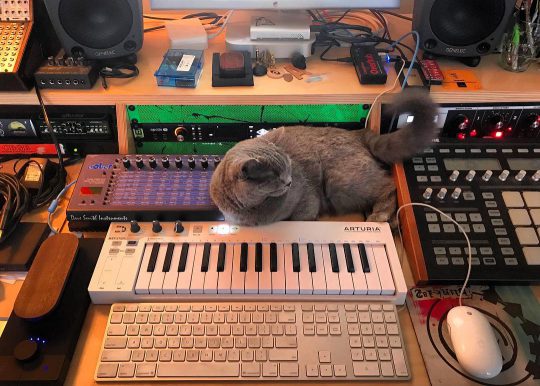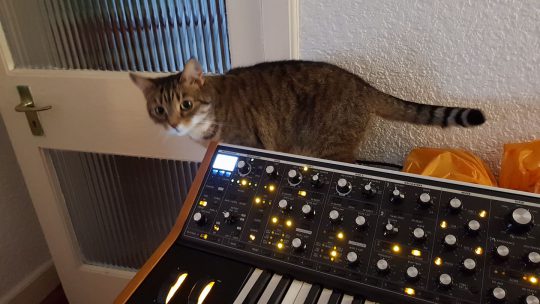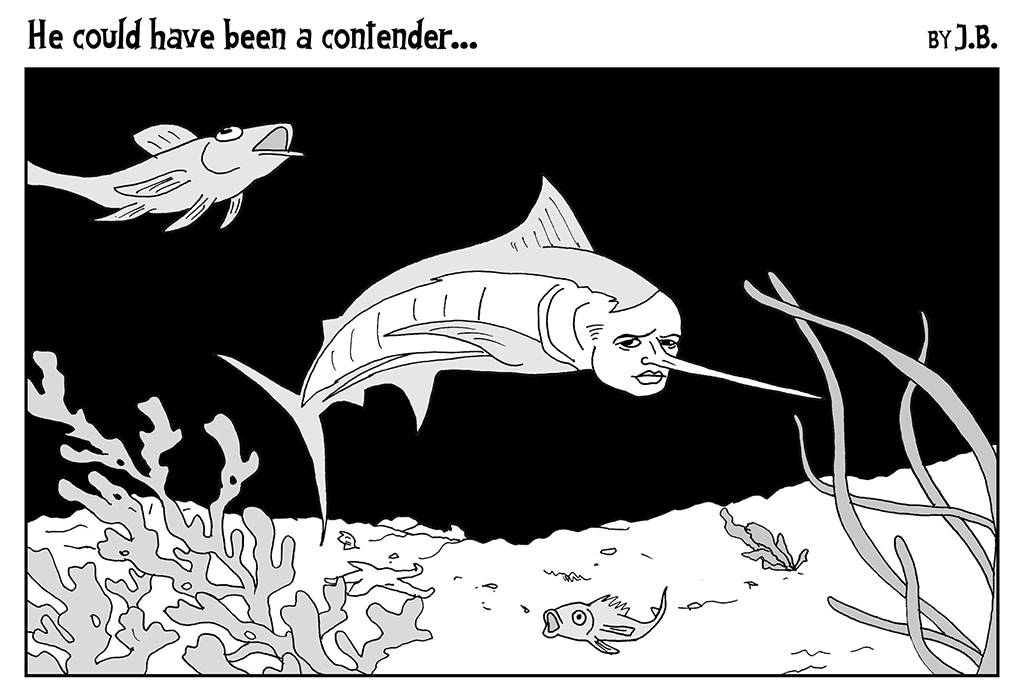
After a brief hiatus over the weekend, we’re back – more on that later. In the meantime, we have this cute photo of Zelda the Gray with a DSI Evolver, Arturia KeyStep, Native Instruments Maschine, and more 😺. From skaterdays on Instagram.


After a brief hiatus over the weekend, we’re back – more on that later. In the meantime, we have this cute photo of Zelda the Gray with a DSI Evolver, Arturia KeyStep, Native Instruments Maschine, and more 😺. From skaterdays on Instagram.

Sam Sam makes her cartoon debut in Boink Boink Basement!, our latest offering from artist J.B.
We think she fits right on with the myriad other fascinating elements in this surreal drawing. And snoopervising is one of the things she does best in creative settings, as can be seen in this previous post.
We have a brand-new CatSynth TV! This one demonstrates a couple of the hidden features of the Moog Sub Phatty synthesizer.
In particular, we look at filter-topology selection and Oscillator 2 beat frequencies. The filter selection makes the instrument much more powerful, moving between the extra crunchy 1 and 2-pole filters to the smooth 4-pole that is “quintessentially Moog”. The beat frequency is a bit more esoteric – it maintains beating frequencies across different pitches, leading to some odd detunings in different registers. But it can add a new timbral-metric component to compositions – something to explore in more depth.
We also look at the Editor/Librarian software from Moog, which is really handy for accessing these features as well as saving patches.
If you have not yet subscribed to our YouTube channel, please do so 😻

This morning we bring you a beautiful black cat with green eyes (like our beloved late Luna), courtesy of our friends at polynominal.com.
We’re pretty sure this is Marcel, who has appeared on CatSynth before, You can see his previous appearances here. As he is the focus of this image optically and conceptually, we are unable to identify the modular synth in the back.
A rainy afternoon like this one at HQ can be a delight. Listening to the polyrhythms of the droplets outside, the gray sky and the shadows, all from a warm comfortable space with a purring cat and favorite music. It can be a great time for focusing on creative projects, or just lying around and experience the “disintegration of thought.”
Rainy days at an office can be more challenging, especially when said office is one of the worst offenders of “forced togetherness.” I retreated into my work, getting better acquainted with the Swift programming language and listening to music on my headphones using the mobile music-play I was tasked with building. To this day, I associate Shuggie Otis’ “Strawberry Letter 23” with rainy days and the mental and personal space I created for myself.
In my mind, I was in a dank 1970s wood-paneled den with a stereo with large speakers – maybe a lava lamp or two – as the gentle rain outside provided a foundational background noise. A bit melancholy but also happy and contented. I also played a lot of Ornette Coleman on our app as I was building and testing it. It was no accident that Lonely Woman rose in the play statistics against the insipid contemporary pop tunes form our top charts and staff picks.
Another aspect of rainy days at this particular office was that our external network often went down. It is rather difficult to work at or run a technology company without internet, so this logically led to an exodus with most of us working from home the remainder of the day. On one occasion, one of the co-founders exhorted us all to come with him to his apartment building with the selling point “we have a rec room!” This was quintessential forced togetherness, as it is unclear what possible benefit a rec room would have to do with getting our work done. Now I don’t know what was going through his mind – perhaps he was just lonely, and maybe he even thought he was being generous – but it was par for the course for a company whose culture seemed about hanging out together. This was, after all, the same company with the coercive lunch behavior that I described in the previous installment of this series. Even before joining, when I balked at an embarrassingly low offer, part of their response was a series of emails and links to blog posts of them hanging out and partying, presumably intended to show me “how cool they were.” This should have been a red flag, but I did not take the warning. A bit older and wiser, I do take such warnings very seriously now when I evaluate business and career opportunities.
However, it still remains an open question as to why young companies, particularly with young founders, tend to put such a premium on togetherness to the point where others are pressured to participate. We will continue to unpack this in future installments of this series.
We learned yesterday of the passing of another of our musical heroes, Cecil Taylor.
This segment of solo piano demonstrates how his playing is incredibly complex but remains thoroughly musical. The fast runs contain a unique contrapuntal language. And more importantly, there is phrasing, contour, and emotion that unifies the performance. Taylor had an uncanny ability to combine European classical tradition, jazz, and other African American influences into a unique musical language that he dubbed “black methodology”. This quote from poet and critic A. B. Spellman, included in the official New York Times obituary, sums it up well.
“There is only one musician who has, by general agreement even among those who have disliked his music, been able to incorporate all that he wants to take from classical and modern Western composition into his own distinctly individual kind of blues without in the least compromising those blues, and that is Cecil Taylor, a kind of Bartok in reverse.”
It is hard for me not to compare Taylor with another contemporary of his, Ornette Coleman, who passed away in 2015. Coleman is one of my favorites – Taylor takes the level of complexity to another level. Both remain huge influences. We leave you with this recording of “Calling It the 9th”.

It seems like it is a week for Cats on Moogs, and in particular cats on Moog Sub 37. From Drew Millar via the Facebook group Synthesizer Freaks – part of the same thread that included Monday’s Cat-on-Sub-37 photo.
Marlon Brando is a controversial figure in contemporary circles, but we did some great movies a long time ago (followed by some not-so-great ones, then a couple more classics, and then some really awful ones). But his work has intertwined with many things at CatSynth over the past couple of years. Consider this cartoon by J.B. (Jason Berry), part of our extended Mensa Cat series.

We leave the joke as an exercise to the reader. 😸
There is also the tune “Marlon Brando” initially composed by Jason Berry for Vacuum Tree Head, which I redid for my own band CDP. Here is a live performance of us playing it at the Make Out Room in San Francisco.
CDP Marlon Brando May 1 from CatSynth on Vimeo.
And finally, our friends at the Cat Museum of San Francisco shared this feline photo today.
